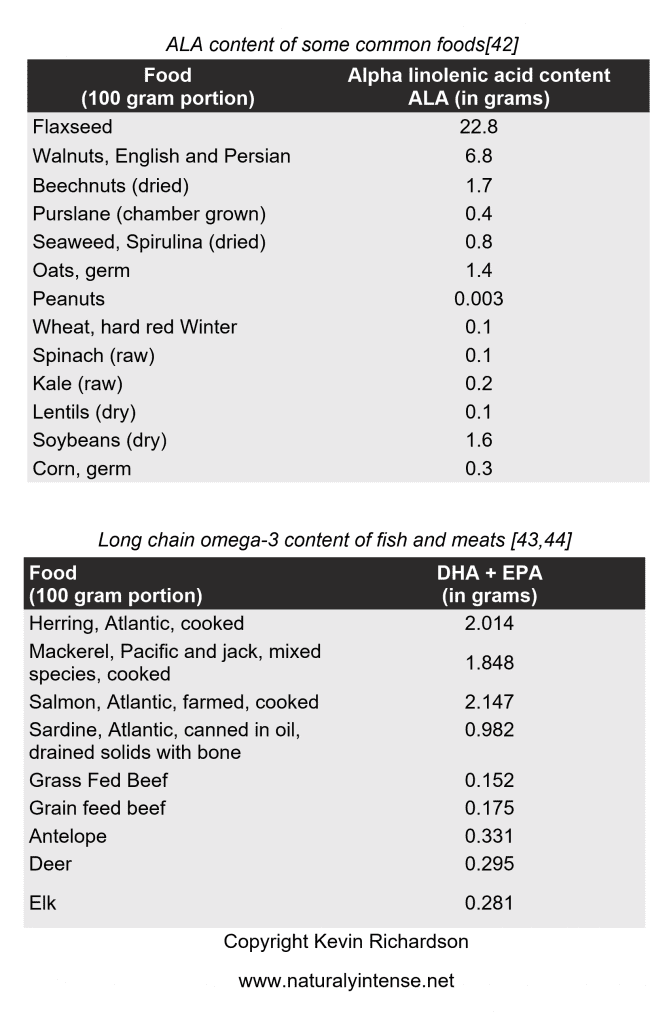
Fish Is Not Necessarily The Best Source Of Long Chain Omega-3 Fatty Acids- An Evolutionary Perspective
The building of brain tissue, unlike other body tissues, is dependent on an adequate supply of long chain omega-3 fatty acids- specifically docosahexaenoic acid (DHA). DHA is a long chain omega-3 fatty acid that appears to have played a key role in the evolution of human intelligence[1] due to its central role in the creation of grey brain matter.[1,2,27] As a result, long chain omega-3’s- (specifically preformed DHA) is added to infant formulas today as almost every professional pediatric organization supports its role as an essential nutrient for infants.[4] In addition, we have a number of studies conducted over the past ten years that show inclusion of long chain omega-3 fatty acids in our diet being as beneficial to our health[5,6,7,8,9,10] Abundant in the marine food chain, preformed DHA and long chain omega-3’s are said to be relatively scarce in terrestrial food sources[11] which raises an important question; How could we, as a species, have evolved within the environmental context of the African plains[2,11,12,13,14, 15] if fish and other marine food sources were not plentiful in this part of the world? The answer goes against most of the literature published regarding optimal sources of long chain omega-3’s as fish and seafood did not become a common part of the human diet until about 20,000 years ago[16]. Considering that we began our time on the planet as humans 1.7 million years ago, it thus becomes apparent that our main source of omega-3’s must have come from the tissues of mammals and other land based foods and not from fish and other marine sources.[3,16] In this article, we take a hard look at the original sources of long chain omega-3’s and highlight that fish oils are not necessarily the best sources for optimal health.
The Role Of The Fish Industry In Promoting Fish Oils As The Best Source Of Omega-3’s

One of the first questions that each of us should ask when investigating the validity of any health claim is ‘Cui bono’- or ‘who stands to gain’. In this case, the extensive efforts of the powerful American and international fish industry lobby played a significant role in the promotion of fish and fish oils as the de facto source of long chain omega-3 fatty acids here in the United States.[22] One would like to think that health claims come as a result of tried and tested scientific proofs or observations, but the reality isn’t as objective as you might like to think. In fact, qualified health claims for fish oils come as a result of decades of pressure piled upon the Food and Drug Administration (FDA) by fish industry lobbies. Initial FDA findings only allowed seafood products to be labeled as ‘rich in omega-3’s’ but were not permitted to attribute any protection against heart disease as there was not enough objective evidence to support such claims.[21,22] In the year 2000, however in response to a major fish industry sponsored lawsuit and continued petitions, the FDA was forced to relax their stance on required scientific standards for health claims on omega-3 fish oil supplements[22], which in 2004 lead to the following ‘qualified health claim’ that brings up more questions than it answers:
‘Supportive but not conclusive research shows that consumption of EPA and DHA omega-3 fatty acids may reduce the risk of coronary heart disease’.[17]
There is little argument against the fact that long chain omega-3 fatty acids do appear to play key roles in human development, but there is some question as to the universal effectiveness of added omega-3’s in the human diet from fish oil sources. Current data neither proves nor disproves a beneficial or a detrimental effect for subgroups of patients with specific underlying pathologies[18] while some studies have found that among certain individuals it may actually increase the likelihood of death from cardiovascular related disease.[18,19,20,45] One review concluded that while fish oils may beneficial in reducing some incidences of sudden death due to cardiac arrhythmias, fish oil supplementation might not be advisable for all patients.[18]
In spite of the many studies conducted and observations of thousands of individuals under controlled and self-reported conditions, the benefits of adding fish oils and fish sources of omega-3’s are not as clear cut as we are often lead to believe. The Agency for Healthcare Research and Quality- the organization responsible for clinical practice guidelines here in the United States, did not find the conclusive evidence for the addition of fish oils to the public diet that you might expect. In fact, their review of 123 studies where the amount of fish oils or omega-3 fatty acids intake was quantified as being significant found that while a higher intake increased measured levels of EPA and DHA, the only consistent benefit across the board was a reduction in triglycerides.[21] Little or no benefit was found for a variety of other cardiovascular risk factors and markers of cardiovascular disease.[21] The review, which without question has been the most comprehensive one thus far with regard to added dietary omega-3 fatty acids concluded that the optimal amounts and sources of omega-3’s are not known, nor is the effects of higher ratios of dietary omega-6 to omega 3 fatty acids[21]- an argument often put forward as a justification for increased fish oil consumption. The review ends with the statement that far more research is needed before any conclusive statements can be made, which is main reason the FDA did not allow any health claims to be made by fish and fish oil producers before being coerced into some concession as a result of lobbying pressures.

The decision to include DHA in infant formula is equally controversial as research has shown that infants can synthesize long chain omega-3 fatty acids themselves from other dietary sources, especially during the last trimester and as such additional omega-3’s may not be required.[23] Some studies suggest that premature infants may benefit from direct consumption while others showed no benefit whatsoever. Blood levels of the long chain omega-3 fatty acids DHA and ARA in breast fed infants are typically higher than levels found in formula fed infants but the scientific evidence for long term benefits remain mixed.[23,24] It should be noted however that most of the studies conducted on the addition of DHA and ARA supplementation in infant formula were sponsored by the infant formula manufacturers themselves and even they were unable to provide any conclusive long term benefits.[22] Once again, and as is custom with the American public health system, pressure from formula makers forced the FDA to agree that the long chain omega-3 fatty acids are naturally occurring components of a regular diet and were thus able to add it to infant formulas without having to prove that such additions would provide any long term benefit.[22]
Understanding The Complexities Of Qualifying Omega-3 Health Benefits In An Imperfect World
What we do know from observations of epidemiological studies is that consumption of plant and marine-derived omega-3 fatty acids seem to be correlated with a reduced incidence of cardiovascular disease[3,37,38,39,40,41] and reduces all-cause mortality, but whether simply adding fish or fish oils to your diet is the answer isn’t very clear. The simple truth is that we do not know as much about omega-3’s and their effects on our bodies from fish oil sources as the fish industry would like us to believe. Global recommendations to eat more fish are problematic not only from a point of view of sustainability, given today’s shrinking fish populations and the fact that aquaculture does not represent a sustainable source if it takes three pounds of menhaden to increase the weight of farmed salmon by one pound. (See Part 1 in our series on omega-3 sources.)
The problem with trying to identify any one nutrient as being responsible for major positive or adverse outcomes is that there are so many other variable that must be taken into consideration- a factor that food industry marketing conveniently overlooks. For example, a cohort study of over 11,875 children found that consumption of less than 340 grams per week of seafood during pregnancy was associated with the child being in the lowest quartile for verbal intelligence as opposed to mothers who consumed over 340 grams of seafood each week.[25] On the surface this sounds like a call for all mothers to start eating more fish but it fails to mention the reality that mothers who ate less seafood were in lower income brackets, had lower education levels and lived in less ideal conditions than the mothers who ate 340 grams of seafood. The association is correlative but not necessarily causative as it is fairly obvious when all the parameters are exposed that the long chain omega-3’s in seafood may not have been the reason for the lower test scores. All of these such associations take away from the reality that fish and seafood were not always staples in our diet and as such they might not be necessary for optimal health.
Natural Land Plant & Animal Sources of Long Chain Omega-3’s

Conventional nutrition studies can often produce conflicting and inconsistent data[26] but an understanding of human dietary habits during the period of our evolution and beyond by observing the practices of healthy populations in modern forging tribes can provide useful and unbiased ways of looking at dietary information. Information that is more in keeping with how we should eat as opposed to how we want to eat in our food abundant environment. One of the key questions as to how early man was able to find adequate sources of long chain omega-3 fatty acids is answered by a simple observation of what we ate at that time. Firstly, Stone Age humans and hunter-gatherer populations today consume not just muscle tissue but relished certain fatty portions of their meats that are not eaten today in our lower omega-3 environments such as brain and bone marrow.[27] While so much fish industry sponsored research is poured into marine sources the fact that the total DHA content of whole brain is 8.6mg/g which is higher than the mean value for a high value omega-3 source fish such as salmon which only yields 6.7 mg/g. Equally important is the fact that the wild animals consumed by by our ancestors and modern foragers such as deer, elk, buffalo and antelope have far higher levels of omega-3’s than grain fed livestock. [27] Grain fed beef has 2-3 times more saturated fat than game meat and 3-4 times less omega-3 polyunsaturated fats. Furthermore, the ratio of omega-6 to omega-3 fats is more than twice that of game animals -An important fact since the presence of omega-6 fatty acids (LA) does appear to inhibit tissue absorption of long chain omega-3’s- especially DHA.[27]) Excessive omega-6 consumption at the expense of omega-3 fatty acids as is common in developed countries with grain fed livestock has also been shown to possibly increase risk of cardiovascular disease and other chronic diseases.[28] Even pasture fed beef, which is much lower in saturated fats and looked upon as the de facto healthy meat choice has 2-3 times less omega-3 polyunsaturated fats than wild game since muscle tissue from both grass and grain fed beef have lower concentrations of long chain omega-3’s. It makes perfect sense since a deer that forages on ferns and mosses (which are in fact high in long chain omega-3’s-especially those growing nearer to water) would have much higher concentrations of long chain polyunsaturated fats when compared to a pasture fed animal.[30,31]

A fundamental mistake with many so called Paleolithic dietary approaches is that it neglects the inconvenient reality that wild game and not livestock animals were staples in our diet for millions of years and that the entire carcass was eaten unlike the practice in developed countries to eat mostly muscle tissue. Thus, wild game and meats such as buffalo are far more natural sources of long chain omega-3 fatty acids, especially when brain tissue is consumed- a factor that debunks the idea that humans required marine resources in order to evolve[29]. As with any complex subject, there are still many other potential sources of long chain omega-3 fatty acids that are yet to be quantified. Hunter gatherers also consumed invertebrates, eggs, fungi and gums[29] – the omega-3 content of which has yet to be studied thanks to emphasis on marine sources. Information on wild plant foods consumed as well is lacking as there are a number of uncultivated fruits and vegetables native to East Africa that have yet been analyzed for omega-3 fatty acid content. Wild plants such as purslane, which is the 8th most commonly distributed plant on the planet is the richest source of omega-3 fatty acids of any green leafy vegetable ever examined with an exceptionally high level of alpha-linolenic acid (ALA) and even trace amounts of EPA and DHA- commonly found in marine sources. [30]
The Omega-3 Paradox- Omega-6 Ratios & Processed Foods

Human studies have shown that the conversion of ALA to long chain omega-3’s was reduced by as much as 50% when dietary intake for LA was increased from 4.7% to 9.3% of caloric intake as a result of the competition between omega-6 and omega-3 fatty acids for desaturation.[32] Thus, the higher body fat reserves of omega-6 fatty acids in modern vegans and omnivores in Western societies is thought to be a major reason why average tissue concentrations of long chain omega-3’s is not as high as is found in societies that consume lower levels of LA. However, a study of the Tsimane forager-horticulturist tribes of Bolivia found that breast milk concentrations of long chain omega-3’s (AA and DHA) were significantly higher than samples taken from mothers in in the United States, even though they frequently consume LA rich plant foods such as maize.[33] Higher percentages of long chain omega-3’s was attributed by the study authors to be due to their diet of predominantly wild game and some freshwater fish but the authors did not take into account possible sources from animal brain tissue. They did acknowledge however that Amazon freshwater fishes are far lower in DHA than cold water species and that fish intake was not as frequent as among coastal populations.[33] What was interesting was that in spite of the fact that Tsimane mothers ate corn almost daily, their average breast milk ratios of omega-6 to omega-3’s was 4/1 as opposed to the American mothers whose ratios came in at 8/1. One explanation put forward is that the higher percentages of LA (and trans fats) in milk samples from American women was due to their consumption of LA rich vegetable oils and processed foods containing LA and hydrogenated oils- thus the problem may not be so much a matter of a simple need for increased omega-3’s but also an avoidance of processed LA rich oils.
Vegetarians & Long Chain Omega-3’s- No Fish But High Omega-3 Levels
One final factor to consider in the argument against fish oil sources of omega-3 fatty acids is the seeming ability of those with low to no intake of fish or long chain omega-3 fatty acids sources to be able to convert plant sourced ALA’s to long chain omega-3 fatty acids in tissue levels comparable to regular fish eaters. One study of over 14,000 vegan men and women, with no intake of dietary EPA or DHA from marine sources still had very high levels of plasma DHA and EPA. [36] As incredible as such a finding may seem it does make sense that our bodies would have evolved in such a way so as to increase conversions from plant source ALA’s to long chain omega-3’s since fish was not a staple of our diet for several million years. Male vegans in the study had only slightly lower levels of DHA than female vegans, and only slightly lower levels than fish-eaters (195 compared to 240 μmol/L plasma). Of note as well is that EPA levels were higher in male vegans than in meat-eating and fish-eating males.[36] Thus far there has only been one large population study to investigate polyunsaturated intakes and blood levels among vegans and far more research is needed as the implications of these findings are that plant and land based foods are more than sufficient sources of long chain omega-3 fatty acids. A finding that would allow for preservation of the global wild fish supply as reliance on fish and fish oils as the only source of health beneficial omega-3’s are not only unsustainable but scientifically questionable.
High Intensity Bodyweight Training: Ballistic Pushups & Dips!
This was a tough one!
Starts out with ballistic push ups (like clap pushups but without the clap as my wrist is still not 100%) nonstop for 20 reps, then all out on dips for 10 reps.
To say it was painful would be an understatement, but you just have to push through and keep on going.
Still training, hope you are too and as always, Excelsior!!! #naturallyintense
#hometraining #homeworkout #homeworkout #highintensitytraining #naturalbodybuilder #naturalbodybuilding #fitover40 #naturalbodybuildingvideos #chestday #chesttraining #naturalbodybuildingtips #pushups #dips #bodyweighttraining #highintensitytrainingtips #drugfreebodybuilding #calesthenics
Kevin's Unconventional Biceps Training- 3-6 Minutes a Week!
In this video I go over my biceps training using the Naturally Intense High Intensity Training protocols that helped me go from having arms measuring 11.5 to 12 inches to 18 inches drug free!
It's an unconventional approach for certain, but it's one that's helped my arms grow and the hundreds of men and women I have trained over the past 30 plus years.
Now, my success isn't due to being genetically gifted, as it took me the better part of 11 years to get my arms up to those measurements.
Which is significant as it works and been been proven time and time again to work for the average man or woman trying to grow their arms without drugs.
It's my hope that these high intensity training protocols can help you as much as they helped me!
Click on my bio link to see the full video on my YouTube channel and thanks as always for taking the time to look at my work!!! Excelsior!!! #naturallyintense
#highintensitytraining #naturalbodybuilder #naturalbodybuilding #fitover40 #naturalbodybuildingvideos #armworkout #bicepsworkout #naturalbodybuildingtips #biceps #armtraining #highintensitytrainingtips #drugfreebodybuilding #barbellcurls
At the Lancaster Classic Day 2 Elimination Rounds Against European Champion, and World Record Holder Leo Pettersen @leo_barebow_archer
I don't talk much about it but I'm also a competitive barebow archer (surprise!) and last Saturday I had the honor of making it to Day 2 at the Lancaster Archery Classic in the Barebow Division, as I made the top 64 out of 267 competitors and had a chance to shoot with some of the greatest barebow shooters on the planet!
I didn't make it past Leo, but it was a real rush to be there and a huge thanks to my coach, Joe MyGlyn @prolinearchery for helping me get there.
Thanks as well to my good friend @sean_chan33 for all of his help from the very start, to my line buddy Aaron Shea for taking the shot and showing up to support!
My thanks as well to rob_kaufhold for putting on and promoting one of the best archery tournaments on earth!
Thanks also to to everyone who took the time to send a supporting word and I am looking forward to next year!!! #naturallyintense #barebow
#lancasterclassic #lancasterarcheryclassic2024 #lancasterarchery #archery #fitover40 #barebowrecurve #targetarchery
Dumbo, Brooklyn circa 2004
This shot was taken as part of the promotion for my Naturally Intense DVD and was about a year after my last bodybuilding competition.
It was a grueling photoshoot.
We started at about 10 am and finished around 4pm and I was completely spent, but the more we shot the sharper I looked, so we kept on going.
It's nice to look back from time to time and as tired as I was, we all had a blast!
My thanks to @stephanie_corne_artwork, @https://pulse.ly/itgnag2dec and @ftaz1 for taking the shots!!!
Thanks for watching and as always, Excelsior!!! #naturallyintense
#naturalbodybuilder #naturalbodybuilding #throwback #fifthavenuegym #5thavenuegym #drugfreebodybuilding #naturalbodybuildinglifestyle #gymlife #gymmotivation #naturalbodybuildingmotivation #bodybuilding #blackandwhite #instablackandwhite #bnw
Can You Build An Impressive Physique Training Only At Home?
Absolutely!
I stopped training in commercial gyms as of March 2020 and have been training at home ever since.
Initially I was admittedly worried that I might lose some of my gains or not make as much progress, but that certainly wasn't the case.
I've consistently continued to improve with my high intensity workouts and muscles have no idea where they are training.
As long as the criteria of adequate intensity and overload are met, there will be an adaptive response and your muscles will get bigger and stronger.
So don't worry at all about where you train, focus instead of what will be the best way for you to always be training!
Thanks for watching and as always, Excelsior!!! #naturallyintense
Kevin's Three Day Training Spilt!
For the past 33 years I have trained three times a week with Naturally Intense High Intensity Training workouts lasting 10, 15 to 20 minutes max.
It's a training split tried and testes not only in it's helping me realize my goal of becoming a successful natural bodybuilder, but it's also helped hundreds of men and women over the past three decades.
I have tested just about every possible training split imaginable and for this particular style of high intensity training, this particular grouping consistently yields fantastic results.
I hope it helps you as much as it's helped me over the years and thanks so much for taking the time to look at my work.
Keep training hard and Excelsior!!! #naturallyintense
Excelsior!!! #naturallyintense
#trainingsplit #3daytrainingsplit #threedaytrainingsplit #naturalbodybuilding #naturalbodybuilder #naturalbodybuildingvideo #naturalbodybuildingmotivation #naturalbodybuildingtips #drugfreebodybuilding #bodybuilding #highintensitytraining #highintensitytrainingtips
405 Stiff Leg Deadlift for 7 Reps! High Intensity Training.
First leg workout of the year and already pushing it!
I haven't done a stiff leg deadlift over 315lbs for about 3 years at this point, and I did my last set with 315lbs and comfortably got to 10 reps and decided I had far too much gas left in the tank and that I should go up in weight.
So I did.
I figured I might get a solid 6 reps in, but I made it to 7 and I think I could have gone on to get a full 10 reps BUT that's when good judgement prevailed.
As a bodybuilder having not trained this heavy for so many years, the shock of this much weight would be more than enough to stimulate muscle growth, and doing more reps wouldn't yield any greater returns, only increase the likelihood of injury.
It's not about the numbers, it's about training to a point where you achieve your goal, and it's important to have a goal in mind as a bodybuilder based on increasing muscle mass rather than hitting a particular number.
Besides, if in my 20's I never did more than 405lbs on a stiff leg deadlift, it doesn't make any sense going heavier than when I am almost 50!
Could I deadlift more at this point?
Absolutely but just because you can doesn't mean you should!
So keep those weights in a good working range, keep it safe and as always Excelsior!!! #naturallyintense
#hometraining #homeworkout #homeworkout #roguerack #highintensitytraining #naturalbodybuilder #naturalbodybuilding #fitover40 #naturalbodybuildingvideos #backworkout #naturalbodybuildingtips #backtraining #highintensitytrainingtips #drugfreebodybuilding #fitoverforty #deadlift
Turning 50 in a few months...
Not much of a big deal for me as I still feel pretty much the same but I hope that my example helps show what can be done with a lifetime commitment to eating well and training consistently!
Thanks for coming along on the journey and as always, Excelsior!!! #naturallyintense
#naturalbodybuilder #naturalbodybuilding #healthylifestyle #fitover40 #drugfreebodybuilding #naturalbodybuildingmotivation #natty #fitness
Please note that all material is copyrighted and DMCA Protected and can be reprinted only with the expressed authorization of the author.
Featured everywhere from the Wall Street Journal to network TV, Kevin Richardson is the international fitness consultant for UNICEF, natural bodybuilding champion, creator of Naturally Intense High Intensity Training and considered one of the best personal trainers in New York City. Click to learn more about his personal training NYC
References for Fish Is Not The Best Source Of Omega 3 Fatty Acids:
1. Bradbury J. Docosahexaenoic Acid (DHA): An Ancient Nutrient for the Modern Human Brain. Nutrients 2011
2. Eaton, S.B., Eaton S.B. III, Sinclair A.J., Cordain L. Mann N.J. Dietary intake of long chain polyunsaturated fatty acids during the Paleolithic.
3. Albert CM, Hennekens CH, O’Donnell CJ, et al. Fish consumption and risk of sudden cardiac death. JAMA. 1998
4. Carlson BA, Kingston JD. Docosahexaenoic acid biosynthesis and dietary contingency: Encephalization without aquatic constraint. Am J Hum Biol. 2007
5. Stahl, L. A., Begg, D. P., Weisinger, R. S., and Sinclair, A. J. The role of omega-3 fatty acids in mood disorders. Current Opinion in Investigational Drugs. 2008
6. Weisinger, H. S., Armitage, J. A., Jeffrey, B. G., Mitchell, D. C., Moriguchi, T., Sinclair, A. J., Weisinger, R. S., and Salem, N. Retinal sensitivity loss in third-generation n-3 PUFA-deficient rats. Lipids. 2002
7. Leaf, A. Historical overview of n-3 fatty acids and coronary heart disease. American Journal of Clinical Nutrition 2008
8. Cleland, L. G., Caughey, G. E., Proudman, S. M., James, M. J., and Lee, A. T. Y. Fish oil treatment and cardiovascular risk in early rheumatoid arthritis. Annals of the Rheumatic Diseases. 2007
9. Proudman, S.M., Cleland, L. G., and James,M. J. Dietary omega-3 fats for treatment of inflammatory joint disease: Efficacy and utility. Rheumatic Disease Clinics of North America. 2008
10. Crawford, M. A., Bazinet, R. P., and Sinclair, A. J. Fat intake and CNS functioning: Ageing and disease. Annals of Nutrition and Metabolism. 2009
11. Turchini, G.M., Nicols P.D., Barrow C., Sinclair A.J. Jumping on the Omega-3 Bandwagon: Distinguishing the Role of Long-Chain and Short-Chain Omega-3 Fatty Acids. Critical Reviews in Food Science and Nutrition 2012
12. Stringer CB, Andrews P. “Genetic and fossil evidence for the origin of modern humans”. Science 1988
13. Cann RL, Stoneking M, Wilson AC. “Mitochondrial DNA and human evolution”. Nature 1987
14. Begun, David R. Miocene Hominids and the Origins of the African Apes and Humans. Annual Review of Anthropology, 2010
15. Wood, Bernard A. “Where does the genus Homo begin, and how would we know?”. In Grine, Frederick E.; Fleagle, John G.; Leakey, Richard E. (eds). The First Humans: Origin and Early Evolution of the Genus Homo. London, UK: Springer 2009
16. Eaton SB: Humans, lipids and evolution. Lipids 1992
17. FDA Announces Qualified Health Claims for Omega-3 Fatty Acids- September 8 2004
18. Brouwer IA, Raitt MH, Dullemeijer C, Kraemer DF, Zock PL, Morris C, Katan MB, Connor WE, Camm JA, Schouten EG, McAnulty J. Effect of fish oil on ventricular tachyarrhythmia. Eur Heart J. 2009
19. Raitt MH, Connor WE, Morris C, Kron J, Halperin B, Chugh SS, McClelland J, Cook J, MacMurdy K, Swenson R, Connor SL, Gerhard G, Kraemer DF, Oseran D, Marchant C, Calhoun D, Shnider R, McAnulty J. Fish oil supplementation and risk of ventricular tachycardia and ventricular fibrillation in patients with implantable defibrillators: a randomized controlled trial. JAMA 2005
20. Brouwer IA, Zock PL, Camm AJ, Bocker D, Hauer RN, Wever EF, Dullemeijer C,Ronden JE, Katan MB, Lubinski A, Buschler H, Schouten EG. Effect of fish oil on ventricular tachyarrhythmia and death in patients with implantable cardioverter defibrillators: the Study on Omega-3 Fatty Acids and Ventricular Arrhythmia (SOFA) randomized trial. JAMA 2006
21. Balk E, Chung M, Lichtenstein A, et al. Effects of Omega-3 Fatty Acids on Cardiovascular Risk Factors and Intermediate Markers of Cardiovascular Disease. Rockville (MD): Agency for Healthcare Research and Quality (US); 2004 Mar. (Evidence Reports/Technology Assessments, No. 93.)
22. Nestle M.: What to Eat. North Point Press 2006
23. FDA/CFSAN Office of Nutritional Products, Labeling and Dietary Supplements July 2002
24. McCann JC, Ames BN. Is docosahexaenoic acid, an n-3 long-chain polyunsaturated fatty acid, required for development of normal brain function? An overview of evidence from cognitive and behavioral tests in humans and animals. Am J Clin Nutr. 2005
25. Hibbeln JR, Davis JM, Steer C, Emmett P, Rogers I, Williams C, Golding J. Maternal seafood consumption in pregnancy and neurodevelopmental outcomes in childhood (ALSPAC study): an observational cohort study. Lancet. 2007
26. Conner WE, Conner SL, Katan MB, Grundy SM, Willet WC. Should a low fat, high carbohydrate diet be recommended for everyone? N. England J Med 1997
27. Cordain L, Watkins BA, Florant GL, Kelher M, Rogers L, Li Y. Fatty acid analysis of wild ruminant tissues: evolutionary implications for reducing diet-related chronic disease. Eur J Clin Nutr. 2002
28. Simopoulos AP. Essential fatty acids in health and chronic disease. Am J Clin Nutr. 1999
29. Crawford MA: The role of dietary fatty acids in biology: Their place in the evolution of the human brain. Nutr Rev 1992
30. Simopoulos AP. Omega-3 fatty acids and antioxidants in edible wild plants. Biol Res. 2004
31. Crawford MA, Gale MM, Woodward MH Linoleic acid and linolenic acid elongation products in muscle tissue of Syncerus caffer and other ruminant species. Biochem J 1969
32. Emken EA, Adlot RO, Gulley RM Dietary linoleic acid influences desaturation and acylation of deuterium-labeled linoleic and linolenic acids in young adult males. Biochem Biophys Acta 1994
33. Martin MA, Lassek WD, Gaulin SJ, Evans RW, Woo JG, Geraghty SR, Davidson BS, Morrow AL, Kaplan HS, Gurven MD. Fatty acid composition in the mature milk of Bolivian forager-horticulturalists: controlled comparisons with a US sample. Matern Child Nutr. 2012
34. Szabo E., Boehm G., Beermann C.,Weyermann M.,Brenner H., Rothenbacher D. et al. Trans octadecenoic acid and trans octadecadienoic acid are inversely related to long-chain polyunsaturates in human milk: results of a large birth cohort study. American Journal of Clinical Nutrition 2007
35. Samur G., Topcu A. & Turan S. Trans fatty acids and fatty acid composition of mature breast milk in Turkish women and their association with maternal dietís. Lipids 2009
36. Welch, Ailsa A; Subodha Shakya-Shrestha, Marleen AH Lentjes, Nicholas J Wareham, and Kay-Tee Khaw. “Dietary intake and status of n−3 polyunsaturated fatty acids in a population of fish-eating and non-fish-eating meat-eaters, vegetarians, and vegans and the precursor-product ratio of α-linolenic acid to long-chain n−3 polyunsaturated fatty acids: results from the EPIC-Norfolk cohort”. The American Journal of Clinical Nutrition 2010
37. Siscovick DS, Raghunathan TE, King I, et al. Dietary intake and cell membrane levels of long-chain n-3 polyunsaturated fatty acids and the risk of primary cardiac arrest. JAMA. 1995
38. de Lorgeril M, Salen P, Martin JL, et al. Mediterranean diet, traditional risk factors, and the rate of cardiovascular complications after myocardial infarction: final report of the Lyon Diet Heart Study. Circulation. 1999
39. Dietary supplementation with n-3 polyunsaturated fatty acids and vitamin E after myocardial infarction: results of the GISSI-Prevenzione trial. Gruppo Italiano per lo Studio della Sopravvivenza nell’Infarto miocardico. Lancet. 1999
40. Burr ML, Fehily AM, Gilbert JF, et al. Effects of changes in fat, fish, and fiber intakes on death and myocardial reinfarction: diet and reinfarction trial (DART). Lancet. 1989
41. Singh RB, Niaz MA, Sharma JP, et al. Randomized, double-blind, placebo-controlled trial of fish oil and mustard oil in patients with suspected acute myocardial infarction: the Indian experiment of infarct survival-4. Cardiovasc Drugs Ther. 1997
42. Raper, N.R., et al . Omega-3 fatty acid content of the US food supply. J. Am. Coll. Nutr. 1992.
43.Marmer WN, Maxwell RJ & Williams JE: Effects of dietary regimen and tissue site on bovine fatty acid profiles. J. Animal Sci. 1984
44. Miller GJ, Field RA, Riley ML & Williams JC : Lipids in wild ruminant animals and steers. J. Food Qual 1986
45. Leaf A, Albert CM, Josephson M, Steinhaus D, Kluger J, Kang JX, Cox B, Zhang H, Schoenfeld D. Prevention of fatal arrhythmias in high-risk subjects by fish oil n-3 fatty acid intake. Circulation 2005







